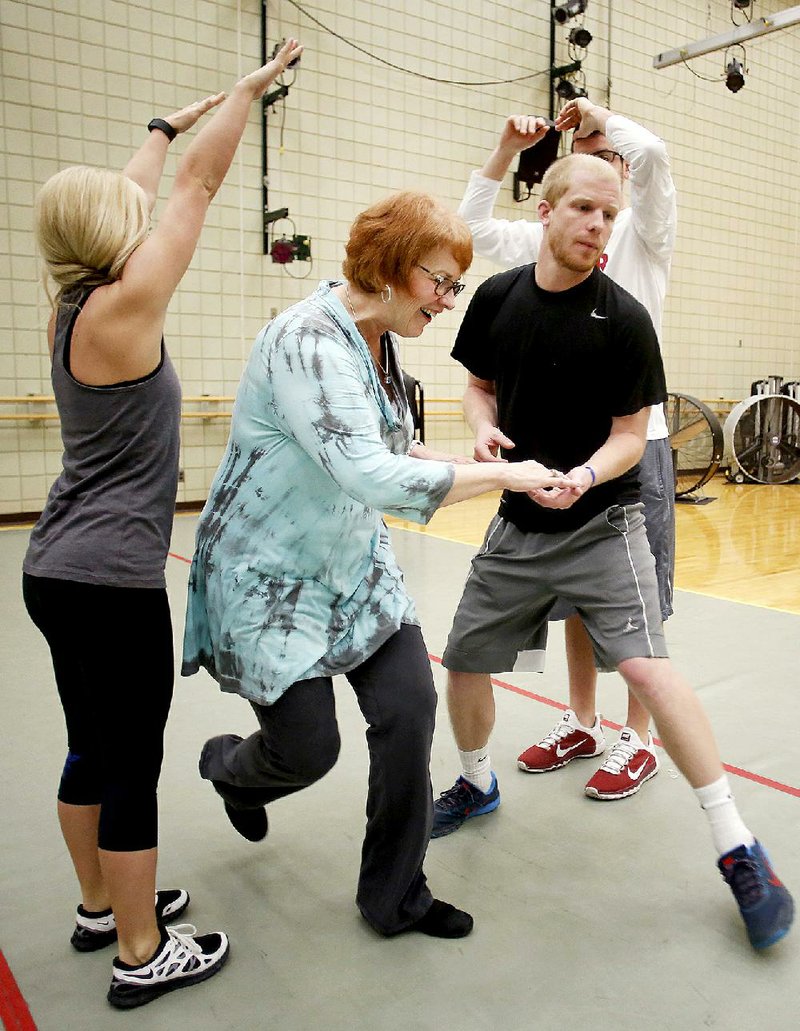FAYETTEVILLE -- Susan Mayes knows the first steps can be shaky for someone learning to dance.
So when teaching University of Arkansas at Fayetteville students, she said she wants to make sure no one feels awkward.
"Once someone feels awkward, they don't want to come back," said Mayes, 64.
She has taught thousands of students basic dance moves during her 34-year career at UA, earning recognition in March from a regional educator's group as 2015 College/University Dance Educator of the Year.
Mayes was nominated and then applied for the award, given out for a 13-state region by the Society of Health and Physical Educators' Southern District.
To help students learn, Mayes said she makes sure they switch partners during class to keep the focus on technique. She said she has also learned when to pull back from pointing out a student's mistakes.
"You need to feel trust and success in order to do well," Mayes said.
Mayes, daughter of longtime UA accounting professor Nolan Williams, began studying dance as a young girl before earning degrees in physical education from UA.
She taught physical education for 10 years at Woodland Junior High School in Fayetteville before joining UA's faculty.
Among her students at UA was Eliese Freeman, now the owner of the Fayetteville dance studio Dance by Eliese.
"She's just eager and available to help with anything she can, even not dance related," Freeman said. After taking a ballroom course in 2009, Freeman returned as a teaching assistant under Mayes.
"She's wonderful with everyone," said Freeman, 25, who credits Mayes with helping her find her own teaching style.
"She eases students into everything that you're doing and doesn't make anyone go faster than what they're ready for," Freeman said.
Mayes has stepped away from teaching ballroom classes. She has an administrative role as undergraduate coordinator for UA's department of health, human performance and recreation. But she still teaches, and on a recent Tuesday morning, she taught a dance class for kinesiology majors who may become physical education teachers.
"What we are doing right now is we are practicing to learn to be teachers and take rhythms into the public schools," Mayes said at the beginning of class.
She began by leading a group of 13 students to a line formation where they faced each other.
With some upbeat western swing music playing in the background, she had them practice simple but fast-paced steps that involved some do-si-do passing of partners down the line.
Before class, Riley Hall, a student manager for the Arkansas Razorbacks men's basketball team, said the course "was not anything that I was looking forward to" when he signed up to fill a requirement for his major.
But the aspiring basketball coach said he has grown to love it.
"It's a lot of fun," he said. As a teacher, Mayes "does a good job of helping us out, but she also wants us to learn on our own," he said.
Mayes said she's seen the number of students planning on becoming a physical education teachers decrease over the years, with 153 students currently enrolled in the kinesiology concentration focused on teaching.
In contrast, more than 700 are majoring in kinesiology with a focus on applied exercise science or pre-professional studies, degrees that could be steps along the way to jobs in athletic training or physical therapy.
The number of students in the teaching-oriented concentration has decreased by more than half over the past three or four years, Mayes estimated.
"For one thing, there are fewer jobs," Mayes said.
She's concerned that Arkansas schools don't pay enough attention to physical education.
"The need is there," Mayes said, noting the state's high obesity rate compared with other states.
A 2014 report from the nonprofit Trust for America's Health and the Robert Wood Johnson Foundation estimated Arkansas' obesity rate at 34.6 percent, the third-highest rate among all states.
"It's just the bigger picture, and the commitment of the districts is not there," Mayes said.
This year, she said she became alarmed at a bill introduced in the Arkansas Legislature to allow school districts greater flexibility in scheduling art, music and physical education.
"I actually wrote all the Senate. I wrote them all an email to please consider voting this down," Mayes said, adding that she used a personal account and her own time to do so.
As first introduced, the bill would have made clear that there would be a 60-minute cap on physical education instruction per week for grade school students.
The bill passed, but "they took off the limit of 60 minutes, which was a small victory in our field," Mayes said.
She said she wanted to avoid forcing any school district into "paring down something they have built up" if they have been offering physical education above state minimums, now set at 40 minutes per week for grade schoolchildren.
Mayes and a UA colleague, Angie Smith Nix, have recently begun visiting local schools to integrate some dance instruction in class discussions.
For example, at Holt Middle School in Fayetteville, the pair talked about some '20s-era music and style while teaching some dance steps to go along with a history course.
"The perfect world for me would be that students would see, or teachers would see, that this is one avenue of getting kids up and getting them to move for three or four minutes. ... It's just an outreach of their physical education program. That's really what I want to see," Mayes said.
Metro on 04/20/2015

